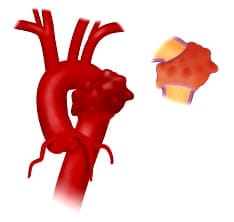 The forward motion of a car crash causes an inflection point where one half of the aorta moves forward and the other moves backward, which causes the vessel to rip. The inflection points of the aorta are in the descending thoracic aorta at the level of the subclavian artery.
The forward motion of a car crash causes an inflection point where one half of the aorta moves forward and the other moves backward, which causes the vessel to rip. The inflection points of the aorta are in the descending thoracic aorta at the level of the subclavian artery.
The grade of the transection determines the patient’s prognosis. A full tear is fatal, but in some cases, the tissue around the tear holds it in place, and these patients are seen in the emergency department.
As the safety of cars improves, airbags are preventing fatal trauma to the head, and more people are instead landing in emergency rooms with aortic transections after motor vehicle crashes. The number of aortic transections is expected to increase in the next five to 10 years as the safety of cars improves.
Patients typically arrive at an emergency department stable but with high-velocity injuries, such as long bone fractures. Traditionally, patients underwent an immediate CT scan and, if they had an aortic transection, they were then rushed to the operating room to repair the aorta. However, evidence in the literature and the experience of CVTI surgeons at Keck Medicine of USC indicate that the best approach is to address the high-velocity orthopaedic injuries first and then repair the aorta.1
Our surgeons prefer to repair the aorta with an endovascular approach, rather than an open surgery, and do so with competitive outcomes. A stent is deployed across the injury to divert blood flow and close the defect. After the procedure, patients spend one day in the intensive care unit and are then transferred to the cardiac unit of Keck Hospital of USC for observation.
Cardiac surgeons at the USC CVTI have made a rip in the aorta — one of the scariest medical events that can happen — into a treatable pathology using an endovascular approach with acceptable risk paradigms and positive results.
While patients are followed for life by the team at the CVTI, most issues that arise for these patients are not due to aortic repair but to the other injuries that occurred in the crash. Cardiac surgeons at the USC CVTI have made a rip in the aorta — one of the scariest medical events that can happen — into a treatable pathology using an endovascular approach with acceptable risk paradigms and positive results.